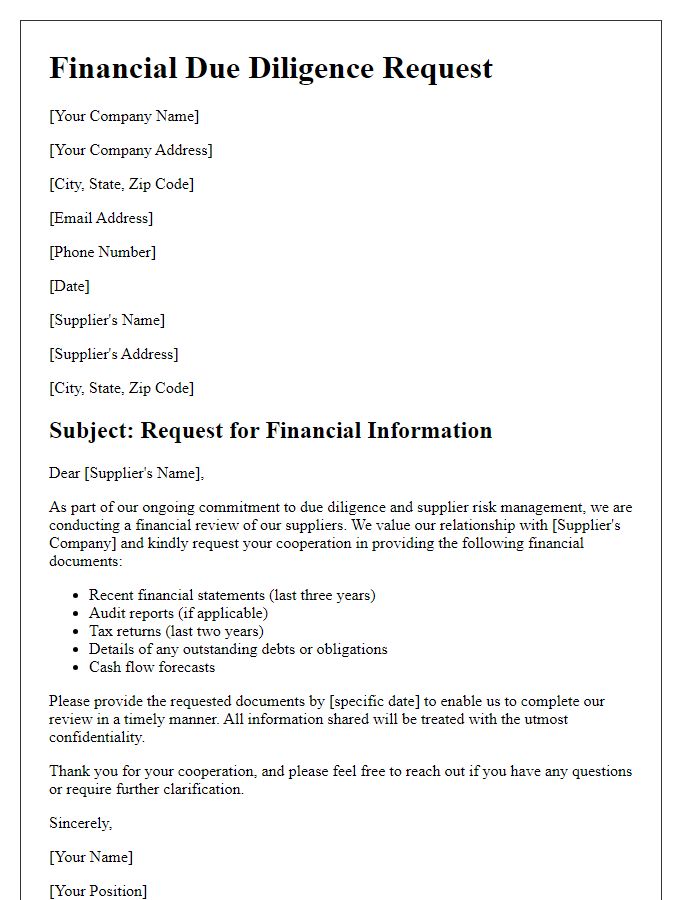When it comes to partnering with vendors, understanding their financial stability is crucial for fostering a reliable business relationship. In this article, we'll explore the key elements to consider when drafting a letter for a vendor financial stability inquiry, ensuring you protect your investments and maintain peace of mind. We're here to guide you through the best practices, helpful tips, and essential questions to ask your potential vendors. Ready to dive in? Let's get started!

Vendor's financial performance metrics
Evaluating a vendor's financial stability is crucial for maintaining a robust supply chain that minimizes potential risks. Key performance metrics such as net profit margin (which should ideally exceed 10% for healthy operations), current ratio (with a standard benchmark of 1.2 for short-term liabilities), and debt-to-equity ratio (favorably under 2.0 for manageable leverage) provide insight into financial health. Additionally, reviewing revenue growth trends (annual increases exceeding 5% indicate positive momentum) and assessing cash flow statements can highlight liquidity issues. Analyzing credit ratings from agencies like Moody's or S&P can further illustrate the vendor's risk profile, allowing for informed decisions regarding partnership sustainability and contract negotiations.
Creditworthiness and risk assessment
Assessing vendor financial stability is crucial in understanding creditworthiness and minimizing risk exposure. Analyzing financial statements such as balance sheets, income statements, and cash flow statements provides insight into liquidity ratios (current ratio and quick ratio) which indicate short-term financial health. Evaluating credit ratings from agencies like Standard & Poor's or Moody's offers a benchmark for credit risk assessment (with ratings ranging from AAA to D). Additionally, reviewing historical payment patterns and days payable outstanding (DPO) can highlight reliability in meeting financial obligations. It is also essential to consider external factors such as market conditions, industry trends, and economic indicators (like the unemployment rate or inflation rate) that may impact vendor stability in the long term.
Historical financial statements
Vendor financial stability is crucial for maintaining a reliable supply chain. Historical financial statements, including balance sheets, income statements, and cash flow statements, provide insights into a vendor's financial health over time. Key metrics such as revenue trends, profit margins, and debt-to-equity ratios reveal the vendor's operational efficiency, profitability, and financial leverage. Analyzing three to five years of historical financial data can indicate long-term stability and growth, allowing businesses to assess risks associated with potential partnerships. Additionally, insights from auditors' reports and any significant changes in financial policies can help evaluate the vendor's risk profile and capacity to meet contractual obligations.
Cash flow and liquidity status
A vendor's financial stability plays a crucial role in assessing their ability to fulfill obligations throughout a contract. Cash flow, which reflects the inflow and outflow of cash resources, is essential for evaluating operational efficiency. A consistent positive cash flow ensures that the vendor can meet immediate expenses, such as payroll and supplier payments. Liquidity status, defined by the vendor's capacity to quickly convert assets into cash, directly impacts their financial health. Metrics like the current ratio, comparing current assets to current liabilities, provide insights into short-term financial resilience. An in-depth analysis of these financial indicators, along with historical balance sheets and income statements, can reveal patterns in fiscal responsibility and operational sustainability for the vendor in question.
Relevant compliance certifications
Vendor financial stability inquiries play a vital role in assessing a supplier's ability to meet obligations and deliver products or services consistently. Essential compliance certifications, like ISO 9001 (quality management), ISO 14001 (environmental management), and SOC 2 (data security), demonstrate a vendor's commitment to quality, sustainability, and information security. Financial health indicators, such as credit ratings and annual revenue figures, provide insights into a vendor's economic resilience. Industry-specific certifications, such as GMP (Good Manufacturing Practices) in pharmaceuticals, reveal adherence to regulatory standards crucial for safety and efficacy. Conducting rigorous assessments of these elements ensures informed decision-making and mitigates the risk of disruptions in supply chains.













Comments